Crime Analytics and the Role of Dynamic Simulation Models
Nick Malleson
Associate Professor
School of Geography, University of Leeds, UK
nickmalleson.co.uk
These slides: http://surf.leeds.ac.uk/presentations.html
Abstract
The 'data deluge', coupled with related 'smart cities' initiatives, have led to a proliferation of information about how people use urban areas. These data are potentially extremely valuable for a number of domains, including crime science. This talk will argue that, because it focuses explicitly on the actions and behaviours of individuals, agent-based simulation is the most appropriate tool for the study of many criminal phenomena. The talk will present two example applications of the methodology to the study of burglary, before outlining wider applications of agent-based modelling to the study of urban dynamics more broadly.
Overview
Dynamic Simulation - Agent Based Modelling
Explanatory Agent-Based Crime Models
Predictive Agent-Based Crime Models
Predictive Policing (?) & Ethical Implications
Modelling Broader Urban Dynamics
Quantifying Ambient Populations
Dynamic Data Assimilation
Why Model Crime?
Exploring theory ('explanatory' models)
Simulation as a virtual laboratory.
Linking theory with crime patterns to test it.
Making predictions ('predictive' models)
Forecasting the impacts of social / environmental change.
Exploring aspects of current data patterns.
Why is it Difficult?
Extremely complex system:
Attributes of the environment (e.g. individual houses, pubs, etc.).
Personal characteristics of the potential offender and/or victim.
Features of the local community.
Physical layout of the neighbourhood.
Potential offender’s knowledge of the environment.
Traditional approaches often work at large scales, struggle to predict local effects
"Computationally convenient".
But cannot capture non-linear, complex systems.

Introduction to ABM
Aggregate v.s. Individual
'Traditional' modelling methods work at an aggregate level, from the top-down
E.g. Regression, spatial interaction modelling, location-allocation, etc.
Aggregate models work very well in some situations
Homogeneous individuals
Interactions not important
Very large systems (e.g. pressure-volume gas relationship)

Introduction to ABM
Aggregate v.s. Individual
But they miss some important things:
Low-level dynamics, i.e. “smoothing out” (Batty, 2005)
Interactions and emergence
Unsuitable for modelling complex systems

Introduction to ABM
Systems are driven by individuals
(cars, people, ants, trees, whatever)
Bottom-up modelling
An alternative approach to modelling
Rather than controlling from the top, try to represent the individuals
Account for system behaviour directly
Autonomous, interacting agents
Represent individuals or groups
Situated in a virtual environment

Attribution: JBrew (CC BY-SA 2.0).
Emergence
One of the main attractions for ABM
"The whole is greater than the sum of its parts." (Aristotle?)
Simple rules → complex outcomes
E.g. who plans the air-conditioning in termite mounds?
Possible to prove the with simple computer programs
Conways 'Game of Life'
Emergence
Why is it important?
Key message: Complex structures can emerge from simple rules
Emergence is hard to anticipate, and cannot be deduced from solely analysis of individuals’ behaviour
You could not work out what a termite mound would look like by dissecting a termite.
Emergence is a characteristic of complex systems
Individual-level modelling is focused on understanding how macro-level patterns emerge from micro-level through the process of simulation.
How is this relevant to crime?
Better Representations of Theory?
Environmental Criminology theories emphasise importance of
Individual behaviour (offenders, victims, guardians)
Individual geographical awareness
Environmental backcloth
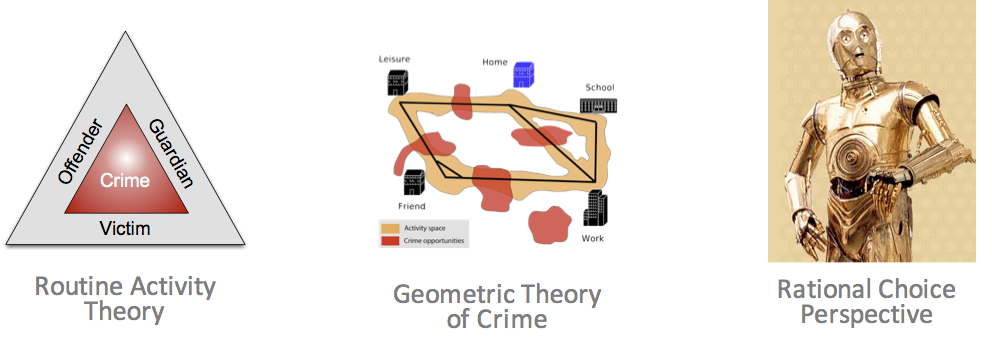
Better Representations of Space?
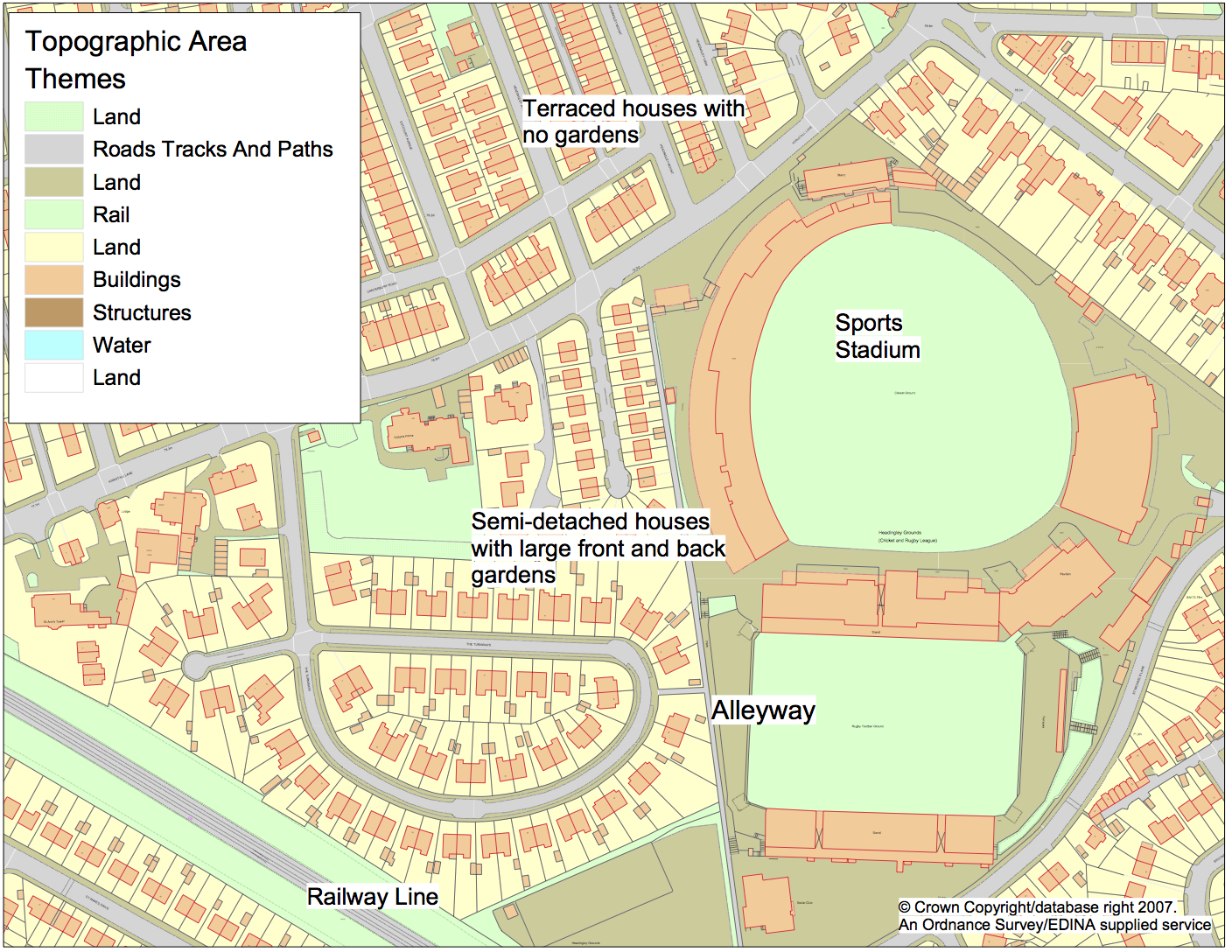
Lots of research points to importance of micro-level environment
Brantinghams' environmental backcloth
Crime at places research (e.g. Eck and Weisburd, 1995; Weisburd and Amram, 2014; Andresen et al., 2016)
Agent-Based Modelling - Appeal
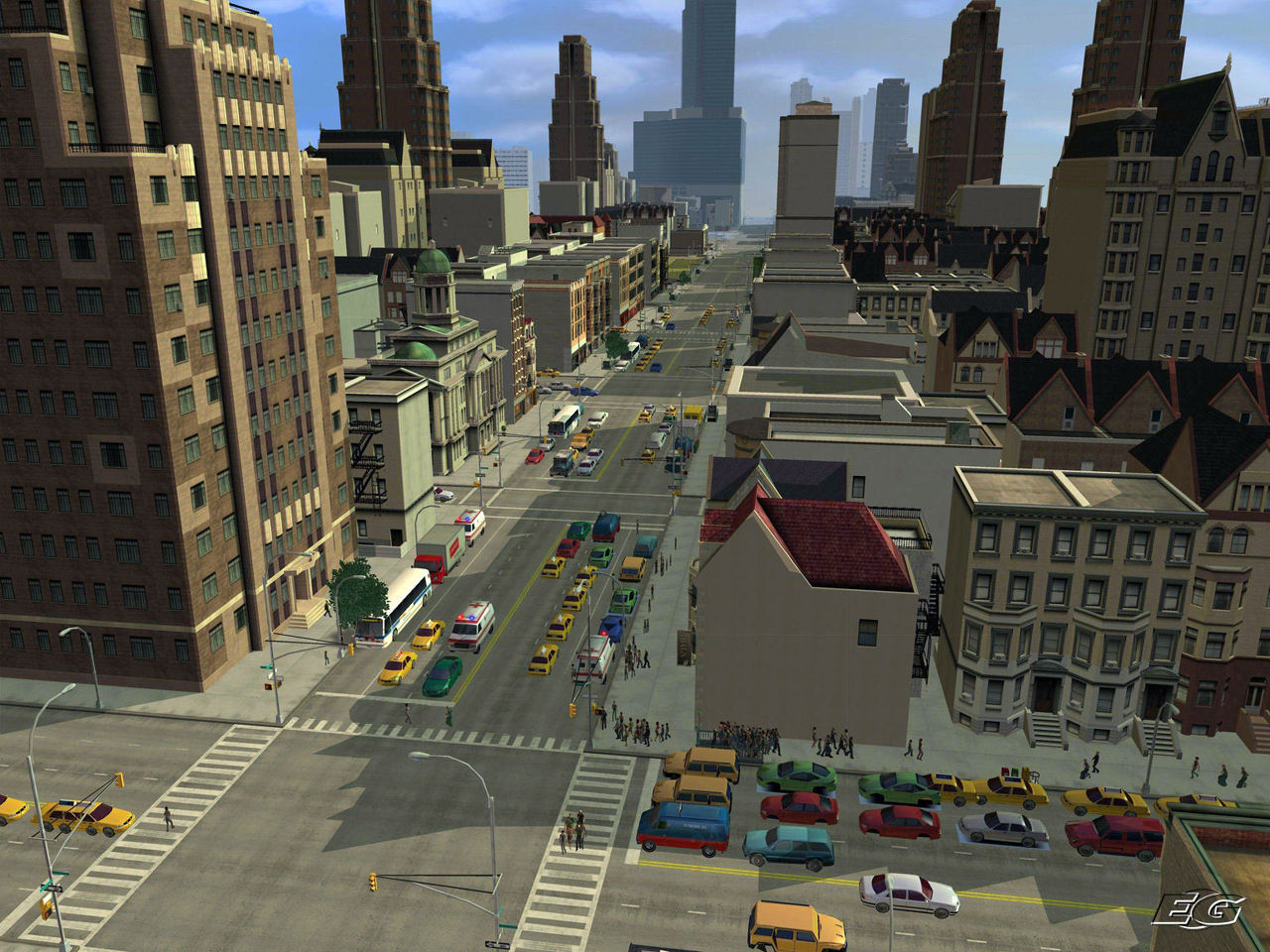
Modelling complexity, non-linearity, emergence
Natural description of a system
Bridge between verbal theories and mathematical models
Produces a history of the evolution of the system
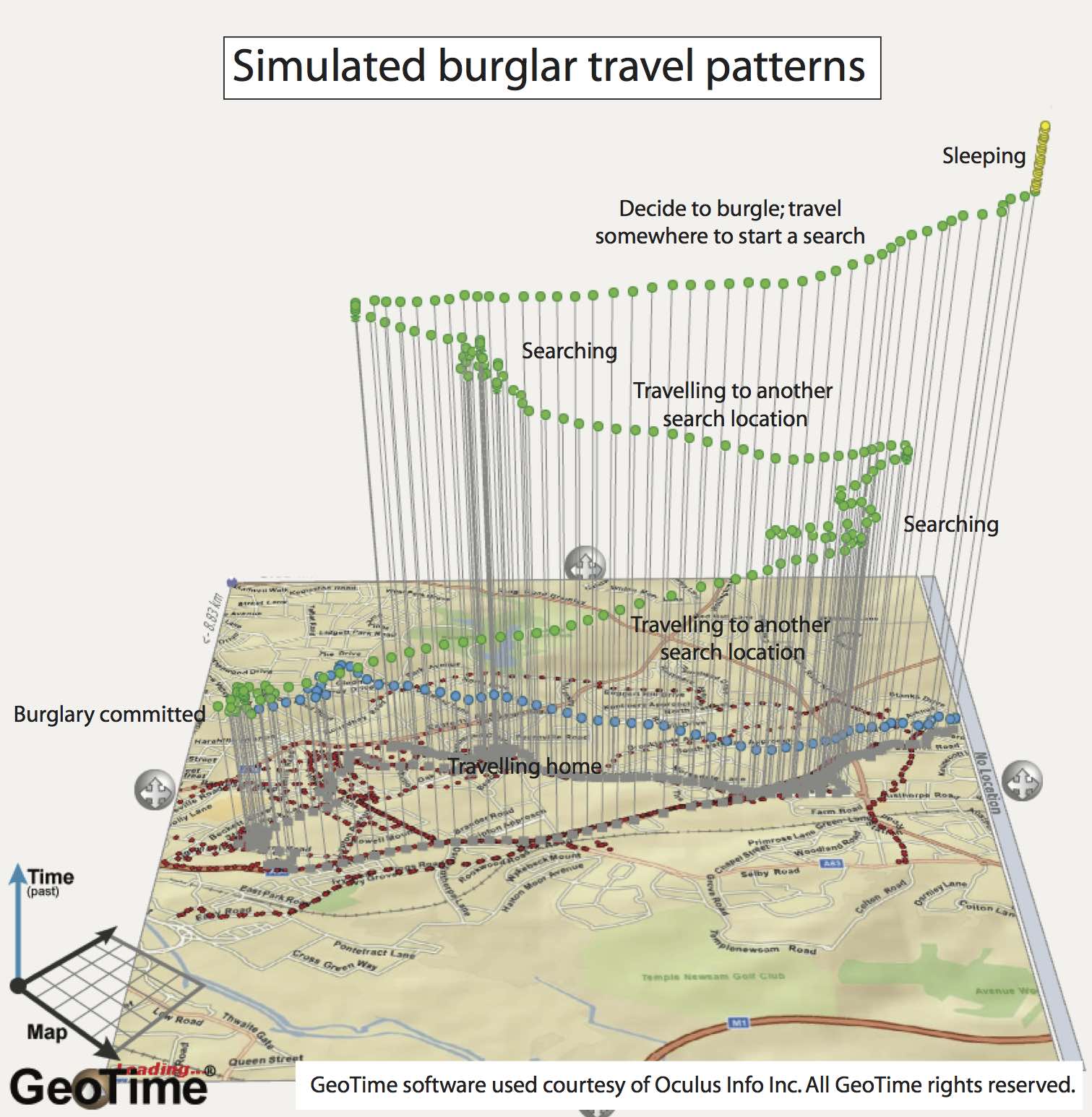
Agent-Based Modelling - Difficulties

(actually he played with his trains...)
Tendency towards minimal behavioural complexity
Stochasticity
Computationally expensive (not amenable to optimisation)
Complicated agent decisions, lots of decisions, multiple model runs
Modelling "soft" human factors
Need detailed, high-resolution, individual-level data
Individual-level data
Creating an ABM
Create an urban (or other) environment in a computer model.
Stock it with buildings, roads, houses, etc.
Create individuals to represent offenders, victims, guardians.
Give them backgrounds and drivers.
See what happens.

Modelling agent behaviours
Many behaviours are hard / impossible to model
Choose those that are the most important. Cannot include everything!
Some can be very simple - e.g. threshold-based rules (Kennedy, 2012)
IF hunger IS ABOVE hunger_threshold THEN search_for_food
OTHERWISE do_something_else
These are the most common (Birks et al. 2012, 2013; Dray et al. 2008; Groff 2007a,b; Hayslett-McCall, 2008)
More advanced cognitive frameworks exist
Beliefs, Desires, Intentions (Bratman et al., 1988)
PECS (Schmidt, 2000).
Who else is doing this?
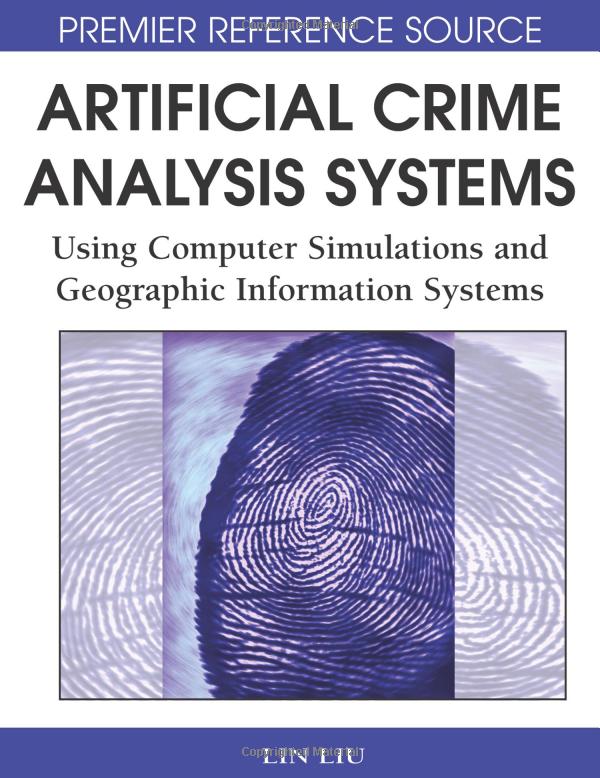
Small, but growing, literature
(apologies to the many who are missing!)
Birks et al. 2012, 2013;
Groff 2007a,b; Hayslett-McCall, 2008
Liu et al. (2005)
Me! (Malleson et. al ...)
A special issue of the Journal of Experimental Criminology entitled "Simulated Experiments in Criminology and Criminal Justice" (Groff and Mazerolle, 2008b)
ABM Explanatory Example (Birks 2012)
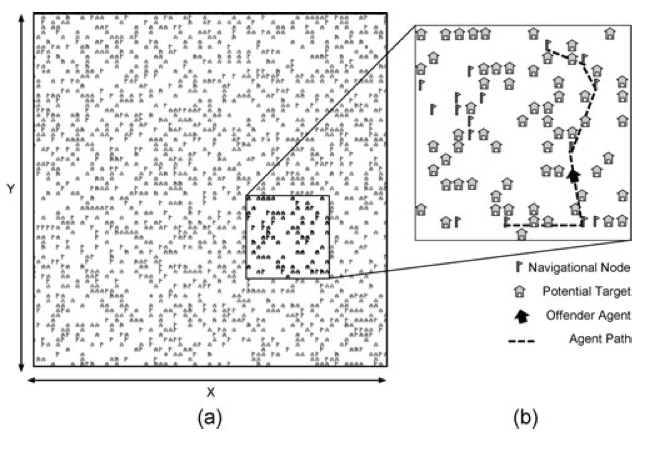
Explanatory: exploring theory
Randomly generated abstract environments
Navigation nodes (proxy for transport network)
Potential targets (houses)
ABM Explanatory Example (Birks 2012)
One type of agent: potential offenders
Behaviour is controlled by theoretical 'switches'
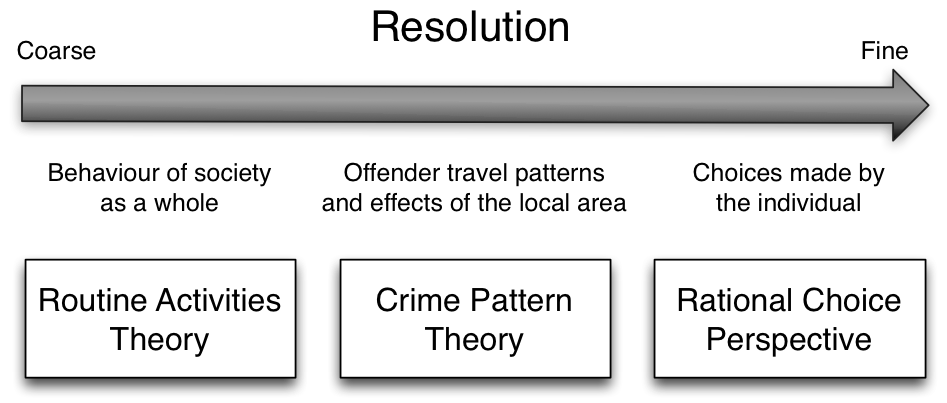
Rational choice perspective (decision to offend)
Routine activity theory (how they move and encounter targets)
Geometric theory of crime (how they learn about their environment)
ABM Explanatory Example (Birks 2012)
Validation against stylized facts:
Spatial crime concentration (Nearest Neighbour Index)
Repeat victimisation (Gini coefficient)
Journey to crime curve (journey to crime curve)
Results:
All theories increase accuracy of the model
Rational choice had a lower influence than the others
Simple / abstract model:
Not directly applicable to practice
But simplicity allows authors to concentrate on theoretical mechanisms
Realistic backcloth might over-complicate model (Elffers and van Baal, 2008)
ABM Predictive Example
Predictive: exploring the real world
ABM to explore the impacts of real-world policies
Urban regeneration in Leeds




ABM Predictive Example
Awareness space test
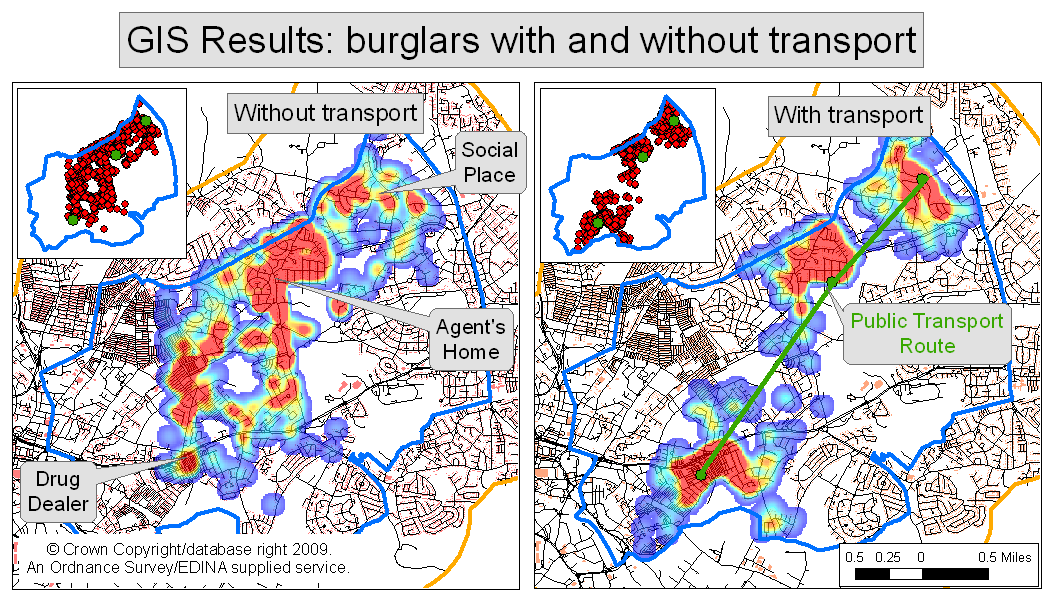
Did it work?
Aggregate results
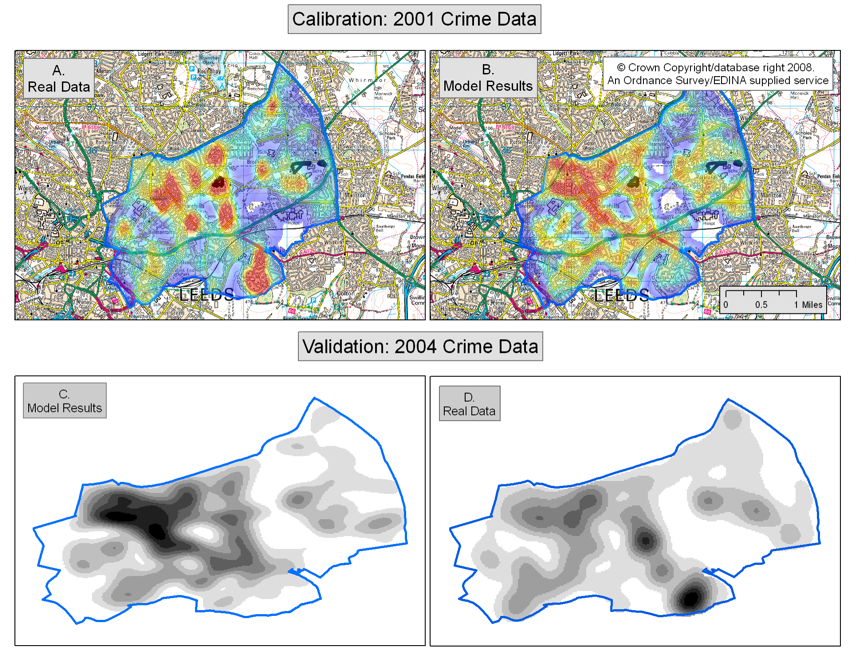
Did it work?
Halton Moor
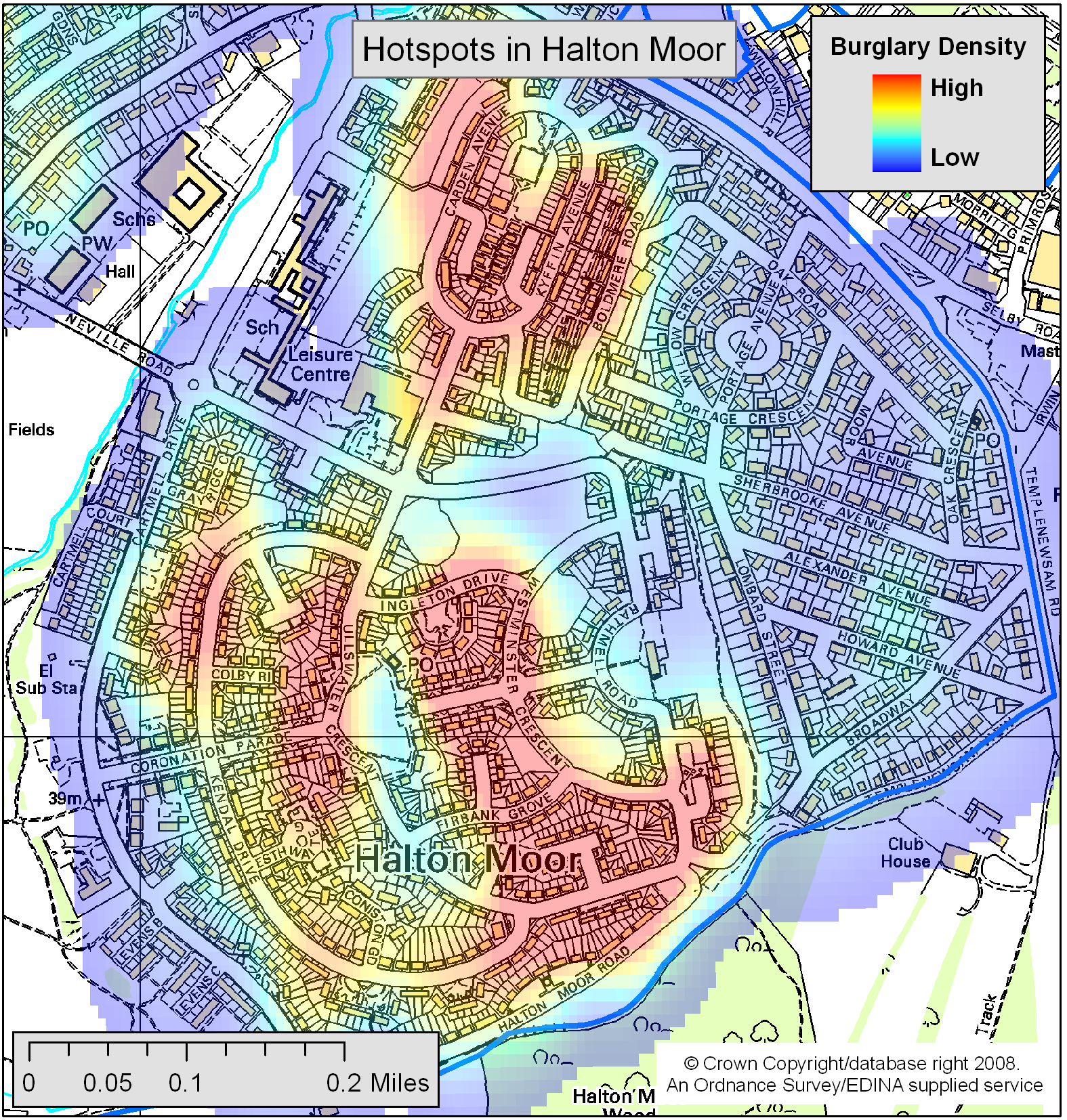
Did it work?
Journey to Crime

ABM Predictive Example
Scenario Results
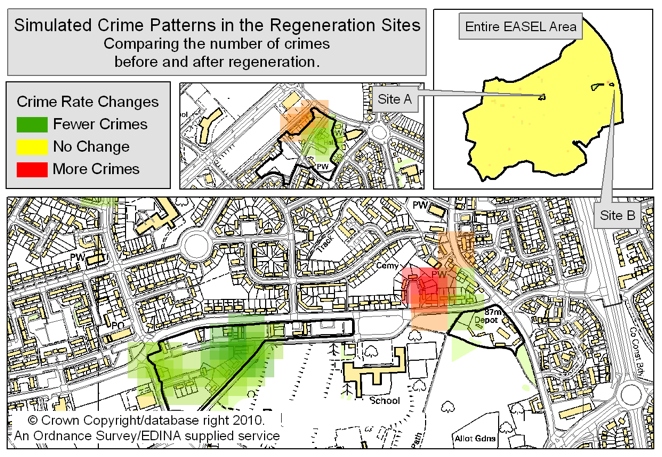
Predictive Intelligent Policing
This is not predictive policing
It could be, in the future, maybe, but not yet
This is a useful tool for exploring the crime system.
It might lead to a better understanding of:
How different behavioural characteristics (offender, victim, or guardian) influence crime outcomes
How the physical infrastructure can be organised to discourage crime
How patrol routes might be most effective
Etc.

Ethics
This is not minority report!
"if an agent-based model is good enough, can it tell me where someone will commit their next crime?"
We can't (and wouldn't want to!) predict when/where/who will commit a crime.
Academics have a role to set the boundaries on what is ethically acceptable
Dynamic simulation models have great potential, we need to make the case that they can be used responsibly
Particularly relevant in the 'big data' / 'smart cities' era (e.g. informed consent)
Data protection / privacy legislation might not be sufficient (often there are clauses for research with crime data)
Other Uses: Modelling Everyone
Quantifying the Ambient population
Daily flows of people have a significant impact on crime rates
But usually have to fall back on residential population for want of data
“The general patterns of movement towards and away from activity nodes such as work or school locations, major shopping areas, entertainment districts or bedroom suburbs provide a very general image of where crimes will concentrate” (Kinney et al., 2008)
We need better models of the ambient population!
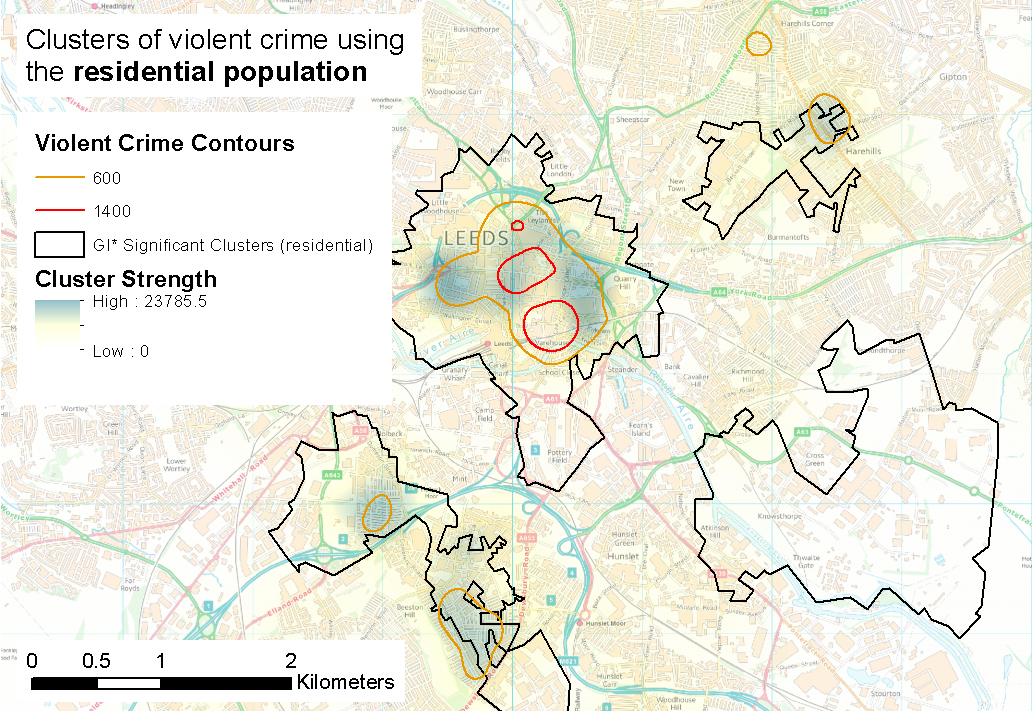
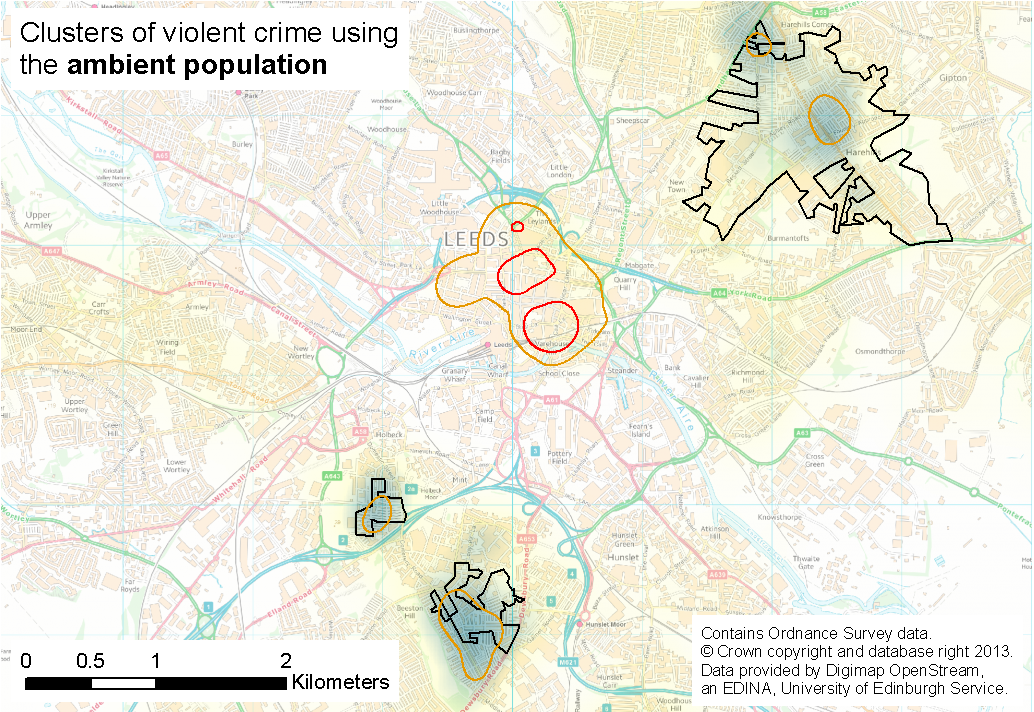
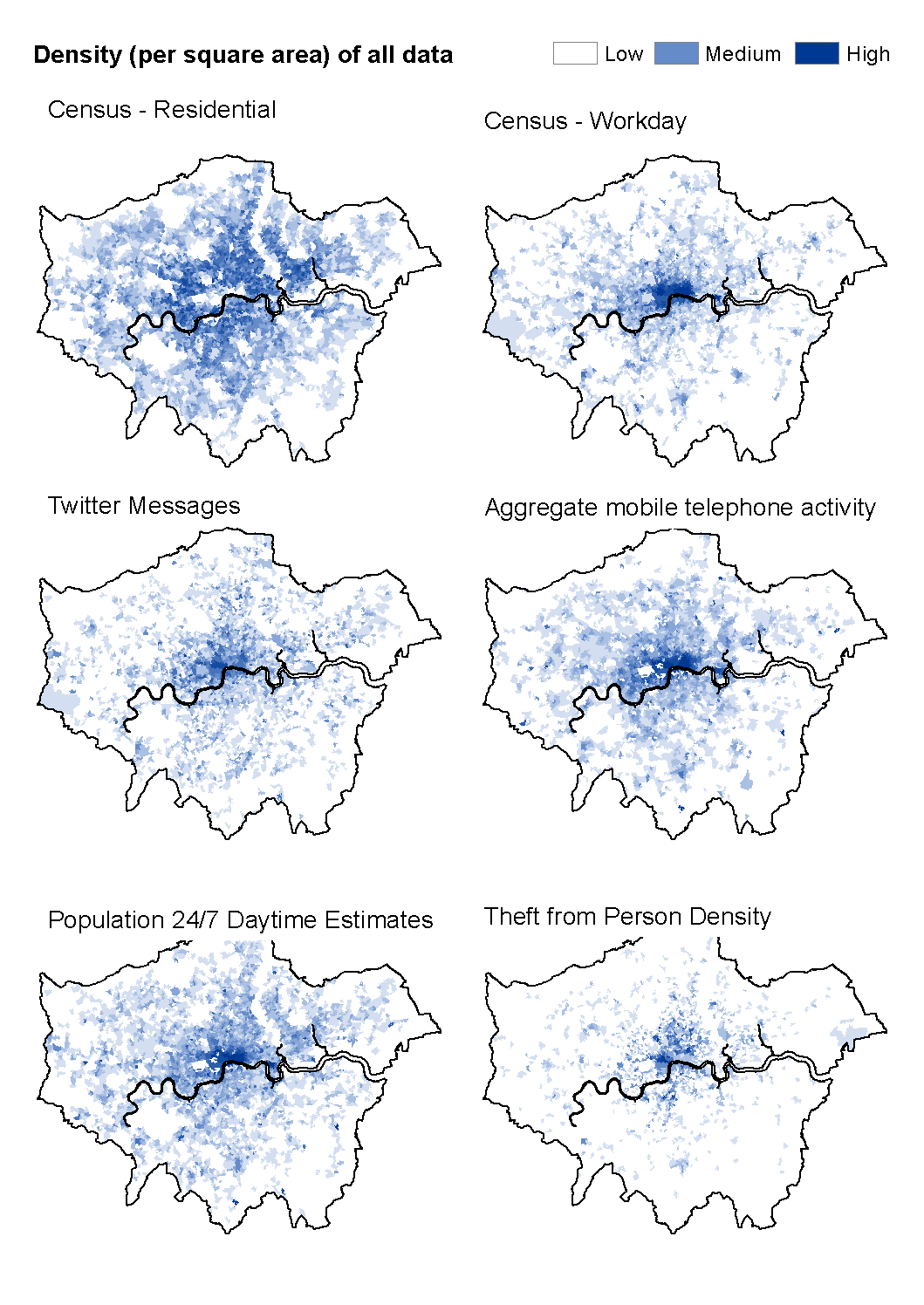
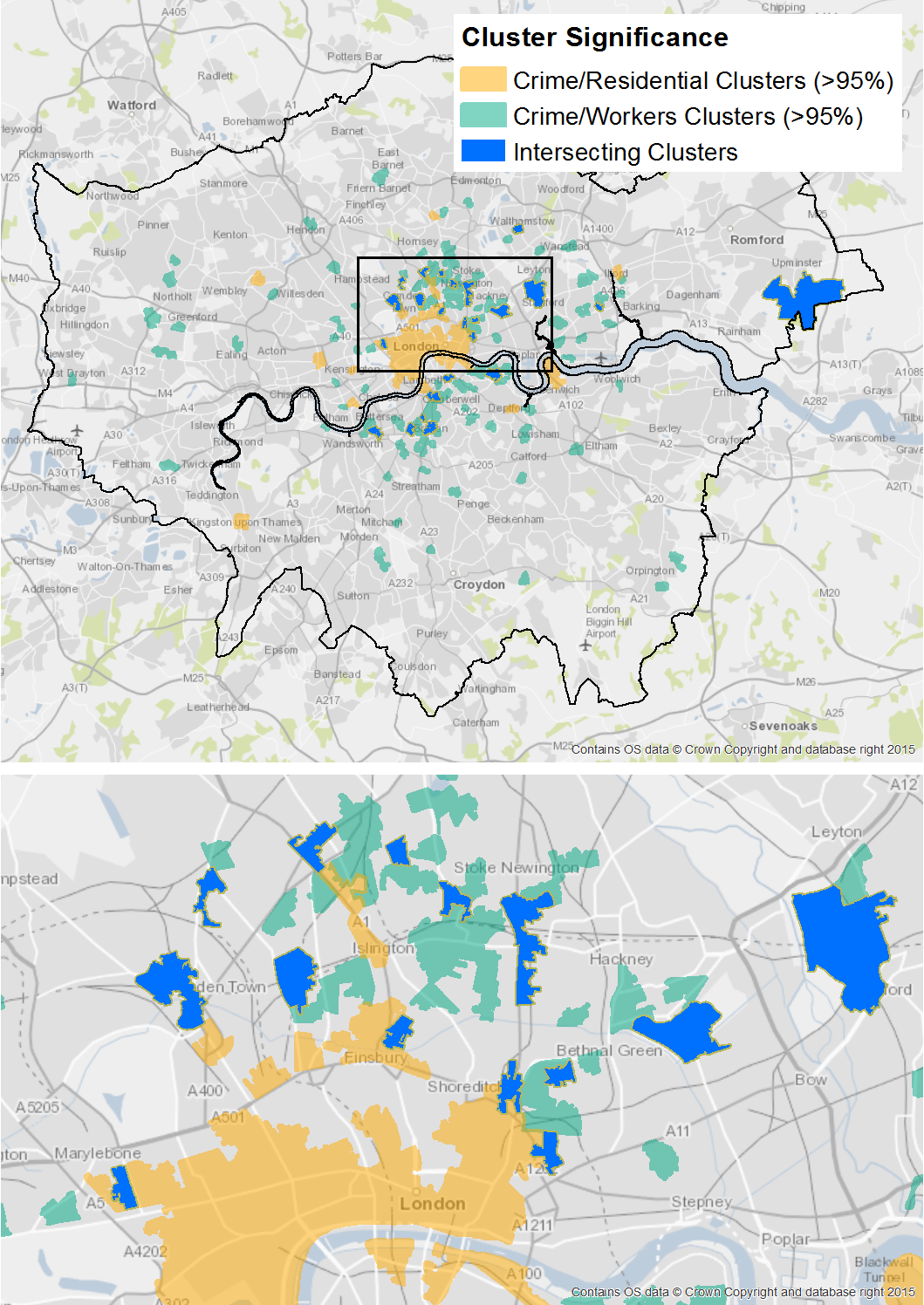
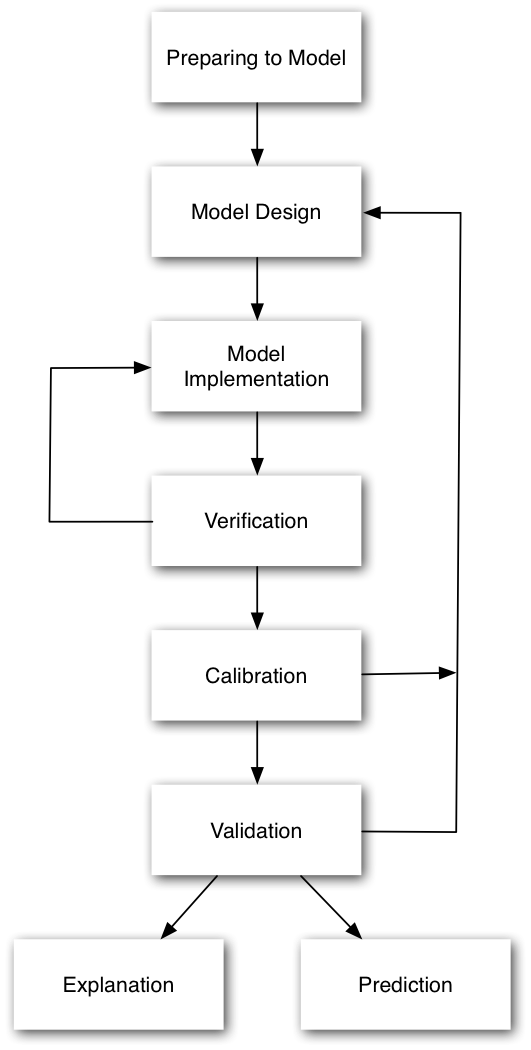
Agent-Based Models of the Ambient Population
Agent-based modelling could do better?
Could combine diverse, up-to-date data with a model to create the most accurate estimate of the real world
But:
Urban systems are complex
They will diverge rapidly from model forecasts
ABM development typically uses 'waterfall' approach
We lack tools to calibrate models dynamically
Dynamic Data Assimilation
Used in meteorology and hydrology to constrain models closer to reality.
Try to improve estimates of the true system state by combining:
Noisy, real-world observations
Model estimates of the system state
Should be more accurate than data / observations in isolation.

Early prototype:
Ensemble Kalman Filter (EnKF)
Maths
Broad literature, but generally tied to mathematical models (e.g. differential equations and linear functions)
Working with a mathematician to do the hard work!
In all its glory: Ward et al., (2016)
Advantages
Similar to Kalman Filter (best in class)
But better for nonlinear systems
Ensemble Kalman Filter - Basic Process
1. Forecast.
Run an ensemble of models (ABMs) forward in time.
Calculate ensemble mean and variance
2. Analysis.
New 'real' data are available
Integrate these data with the model forecasts to create estimate of model parameter(s)
Impact of new observations depends on their accuracy
3. Repeat
Ensemble Kalman Filter (EnKF)
Outline

Simulating Urban Flows (surf)
Big Data, ABM, Smart Cities, Ambient Populations
A city-wide dynamic ABM, constantly re-calibrated to streaming data
New insights into urban mobility patterns and footfall estimates.
Future Work: DUST
Data Assimilation for Agent Based Models: Applications to Civil Emergencies
Recently funded by the ERC (Starting Grant), €1.5M over 5 years
Starts on 1st January 2018
For more information:
https://erc.europa.eu/news/erc-2017-starting-grants-highlighted-projects
Shameless Advertising
The Leeds Institute for Data Analytics

New, ~ £10M investment in a multidisciplinary centre for data analytics
Big role for agent-based modelling and crime science
E.g. forthcoming seminar: Difficulties with reproducible data analytics: Pitfalls in predictive policing
Summary
Dynamic Simulation - Agent Based Modelling
Explanatory Agent-Based Crime Models
Predictive Agent-Based Crime Models
Predictive Policing (?) & Ethical Implications
Modelling Broader Urban Dynamics
Quantifying ambient Populations
Dynamic Data Assimilation
References
Andresen, M. A., Linning, S. J., and Malleson, N. (2016). Crime at Places and Spatial Concentrations: Exploring the Spatial Stability of Property Crime in Vancouver BC, 2003–2013. Journal of Quantitative Criminology, pages 1–21.
Birks, D., Townsley, M., and Stewart, A. (2012). Generative Explanations of Crime: Using Simulation to Test Criminological Theory. Criminology, 50(1):221–254
Birks, D., Townsley, M., and Stewart, A. (2013). Emergent Regularities of Interpersonal Victimization: An Agent-Based Investigation. Journal of Research in Crime and Delinquency.
Bratman, M. E., Israel, D. J., and Pollack, M. E. (1988). Plans and resource-bounded practical reasoning. Computational Intelligence, 4(3):349–355.
Dray, A., Mazerolle, L., Perez, P., and Ritter, A. (2008). Policing Australiaâ’s heroin drought: using an agent-based model to simulate alternative outcomes. Journal of Experimental Criminology, 4(3):267–287.
Eck, J. and Weisburd, D. (1995). Crime places in crime theory. In Eck, J. and Weisburd, D., editors, Crime and Place, pages 1–33. Criminal Justice Press.
Elffers, H., and P. van Baal. 2008. “Realistic Spatial Backcloth Is Not That Important in Agent Based Simulation Research: An Illustration from Simulating Perceptual Deterrence.” In Artificial Crime Analysis Systems: Using Computer Simulations and Geographic Information Systems, 19–34. Hershey, PA: Information Science Reference.
Groff, E. (2007a). Situating Simulation to Model Human Spatio Temporal Interactions: An Example Using Crime Events. Transactions in GIS, 11(4):507–530.
Groff, E. R. (2007b). Simulation for Theory Testing and Experimentation: An Example Using Routine Activity Theory and Street Robbery. Journal of Quantitative Criminology, 23(2):75–103.
Hayslett-McCall, K., Qui, F., Curtin, K. M., Chastain, B., Schubert, J., and Carver, V. (2008). The Simulation of the journey to residential burglary. In Liu, L. and Eck, J., editors, Artificial Crime Analysis Systems: Using Computer Simulations and Geographic Information Systems. Information Science Reference, Hershey, PA.
Kennedy, W. G. (2012). Modelling Human Behaviour in Agent-Based Models. In Heppenstall, A. J., Crooks, A. T., See, L. M., and Batty, M., editors, Agent-Based Models of Geographical Systems, pages 167–179. Springer Netherlands.
Liu, L., Wang, X., Eck, J., and Liang, J. (2005). Simulating crime events and crime patterns in RA/CA model. In Wang, F., editor, Geographic Information Systems and Crime Analysis, pages 197–213. Idea Publishing, Reading, PA.
Malleson, N. and A. Evans (2013) Agent-Based Models to Predict Crime at Places. In G. Bruinsma and D. Weisburd (Eds) Encyclopedia of Criminology and Criminal Justice pp 41-48 . Springer.
Malleson, N. “Agent-Based Modelling of Burglary.” School of Geography, University of Leeds, UK, 2010.
Malleson, Nick, Alison Heppenstall, and Linda See. “Crime Reduction through Simulation: An Agent-Based Model of Burglary.” Computers, Environment and Urban Systems 34, no. 3 (2010): 236–50.
Malleson, Nick, Linda See, Andrew Evans, and Alison Heppenstall. “Optimising an Agent-Based Model to Explore the Behaviour of Simulated Burglars.” In Theories and Simulations of Complex Social Systems, edited by Vahid Dabbaghian and Vijay Kumar Mago, 179–204. Intelligent Systems Reference Library 52. Springer Berlin Heidelberg, 2014.
Ward, J., A. Evans, N. Malleson (2016) Dynamic calibration of agent-based models using data assimilation. Royal Society Open Science. 3:150703. (open access). [DOI: 10.1098/rsos.150703]
Weisburd, D. and Amram, S. (2014). The law of concentrations of crime at place: the case of Tel Aviv-Jaffa. Police Practice and Research, 15(2):101–114.